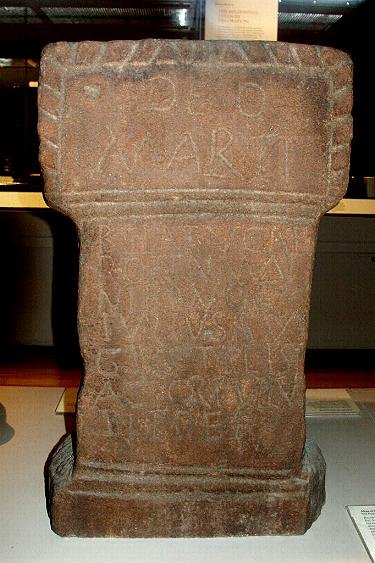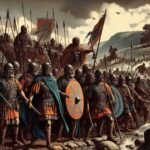Roman Military Sites in Scotland
|
||
| FRONTIERS | Gask Ridge |
The Gask Ridge frontier is a group of towers, forts and fortlets that run from south of Ardoch fort to Bertha. It is possible that the series extends further south to Doune or even to the Clyde-Forth isthmus. The little dating evidence that exists gives its abandonment at circa 87AD, but there is now evidence for a longer occupation than the traditional very short one that has been dated from either before the building of Inchtuthill fortress or just after that fortresses’ abandonment. The Gask appears to be the oldest known land frontier system anywhere in the Empire. See Perth and Kinross for site entries
Woolliscroft, The Roman Gask in Limes Congress Report 1997 (1997) pp499-519 and at https://www.morgue.demon.co.uk/Pages/Gask/Britannia.html The Roman Gask Project Keppie, Scotland’s Roman Remains (1990) p183 |
| Antonine Wall |
Earth or turf wall on stone base running for 60 km from Old Kilpatrick on the Clyde to the Firth of Forth near Carriden. It was built circa 140 AD. The original plan was for six forts (the Primary forts – Carriden, Mumrills, Castlecary, Bar Hill or Auchendavy, Balmuildy and Old Kilpatrick) about every 12.8 km and fortlet (similar to the mile castles on Hadrian’s Wall) at approximately every Roman mile.
The mile fortlets were then abandoned and 13? small (Secondary) forts inserted about every 3.2 km. The Wall also has small ‘expansions’ the purpose of which are unknown. There are many temporary camps close to the Wall that sheltered the troops on building duties. Strathclydde and Central for detailed entries Keppie, Scotland’s Roman Remains (1990) pp180-181 |
|
| ABERDEENSHIRE |
Balmakewan NO6666 |
Marching camp, circa 50.0 ha Journal of Roman Studies LXVII, p143 (1977) |
| Burnfield NJ5447 |
Marching camp Britannia XV, p273 (1984) | |
| Durno NJ6927 |
Marching camp, circa 58.0 ha – Flavian date? One of the suggested sites for Agricola’s camp before the battle of Mons Graupius. Frere & St Joseph, Roman Britain from the air, p30-1 (1983) | |
| Dun NO6859 |
Marching camp, 3.3 ha. As it is on a coastal site it may be associated with Agricola’s sixth campaign, where fleet and army acted together. Scottish Archaeological Forum XII, p45-7 Edinburgh (1981) | |
| Glenmailen NJ6538 |
Marching camp, 44.9 ha (Serveran?) Britannia I, p174-7 (1970) | |
| NJ6635 | Marching camp, 14.1 ha, Flavian with “Stracathro” gateways Britannia I, p174-7 (1970) | |
| Kair House NO7676 |
Marching camp, 52.6 ha (Serveran?) Journal of Roman Studies LXVII, p143 (1977) | |
| Kintore Devona? NJ7816 |
Marching camp, 44.5 ha Proceedings of the Society of Antiquaries of Scotland CXVI, p 205 – 9, 1986 | |
| Normandykes NO8399 |
Marching camp, 42.9 ha (Serveran?)Journal of Roman Studies LXVII, p143 (1977) | |
| Raedykes NO8490 |
Marching camp 37.6 ha, Flavian. One of the suggested sites for Agricola’s camp before the battle of Mons Graupius.Hanson, Agricola and the conquest of the North, pp130-6 (1987) | |
| Ythan Wells See Glenmailen |
||
| ANGUS |
Cardean Tameia NO2846 |
3.2 ha Flavian fort, abandoned in the mid 80s AD.Britannia VII, p299 (1976) |
| Eassie NO3546 |
Marching camp, 25.5 haBritannia I, p177 (1970) | |
| Finavon NO4957 |
Marching camp, 15.0 haJournal of Roman Studies LXVII, p140 (1977) | |
| Gagie NO4438 |
Small marching campJournal of Roman Studies LXIII, p224 & p 229 (1973) | |
| Inverquharity NO4058 |
0.5 ha Flavian fortlet, abandoned around 87 AD.Britannia XV, p275 (1984)
Marching camp, 2.3 ha Britannia XVI, p263 (1985) |
|
| Keithock NO6163 |
Marching camp, 26.6 haJournal of Roman Studies LXIII, p84 (1973) | |
| Kirkbuddo NO4944 |
Marching camp, 24.3 haJournal of Roman Studies LXIII, p230 (1973) | |
| Longforgan NO2930 |
Marching camp, 25.9 ha Britannia XXVI | |
| Lunanhead NO4752 |
Marching camp, 25.5 haJournal of Roman Studies LXIII, p224 (1973) | |
| Marcus NO5158 |
Marching camp, 26.2 haJournal of Roman Studies LIX, p111 (1969) | |
| Oathlaw NO4555 |
Marching camp, 52.6 ha (Severan?).Journal of Roman Studies LXVII, p143 (1977) | |
| Stracathro NO6165 |
Flavian fort, 2.6 ha that was abandoned around 87 AD Britannia I, p273 (1970)
Flavian marching camp, 15.7 ha. The type site for “Stracathro” gateways. Britannia I, pp171-5 (1970) |
|
| EAST AYRESHIRE |
Loudoun Hill NS60371.4 ha |
Flavian fort, abandoned after the late 80s AD.The site was re-occupied in the Antonine period.
Kennedy, Britannia VII pp286-7 (1976) |
| SOUTH AYRESHIRE |
Girvan NX1999 |
Two marching camps, 21 ha and 13 ha Britannia XXV (1994) p257 |
| EAST DUNBARTONSHIRE |
Adamslee NS6473 |
Marching camp, 1.4 haRoyal Commission on the Ancient and Historical Monuments of Scotland, Lanarkshire, p134(1978) |
| Auchendavy NS6774 |
Primary Antonine Wall fort, 1.4 haBritannia XVI, pp29-35 (1985) | |
| Balmuildy NS5871 |
Primary Antonine Wall fort, 1.7 haGlasgow Archaeological Journal IV, pp99-102 (1976) | |
| Buchley NT5972 |
Antonine Wall mile fortlet?Britannia XII, p320 (1981) | |
| NS5872 | Expansion on the Antonine WallBritannia XIV, p227-43 (1983)
Marching camp, 4.5 ha Royal Commission on the Ancient and Historical Monuments of Scotland, Lanarkshire, pp114 |
|
| Cadder NS6172 |
Secondary Antonine Wall fort, 1.4 ha. The site has now been now destroyed.Royal Commission on the Ancient and Historical Monuments of Scotland, Lanarkshire, pp121-4 | |
| Castlehill NS5272 |
Secondary Antonine Wall fort 1.4 ha and possible mile fortlet. Garrisoned by Cohors IIII Gallorum equitata.Hanson & Maxwell, Rome’s North-West Frontier, p91 Edinburgh (1983) | |
| Cleddans NS5072 |
Antonine Wall mile fortlet, 0.1 haBritannia XII, p154-6 (1981) | |
| Duntocher NS4972 |
Secondary Antonine wall fortAntonine Wall mile fortlet, 0.3 ha
Britannia X, p278 (1979) |
|
| Glasgow Bridge NS6373 |
Antonine Wall mile fortlet, 0.1 haRoyal Commission on the Ancient and Historical Monuments of Scotland, Lanarkshire, pp134 | |
| Kirkintilloch NS6574 |
Secondary Antonine Wall fortRobertson, The Antonine Wall pp74-6 (1979) | |
| Twechar NS6975 |
Marching camp, 1.5 haBritannia IX, p416 (1978) | |
| Summerston NS5772 |
Antonine Wall mile fortlet Marching camp, 2.4 ha, a construction camp for the Antonine Wall?.
Britannia XIII, p98 (1982) |
|
| Wilderness Plantation NS5972 |
Antonine Wall mile fortlet, 0.1 ha Britannia VI, p227 (1976)
Expansions. on the Antonine Wall – Wilderness East and West. Hanson & Maxwell, Britannia XIV, p227-43 (1984) |
|
| WEST DUNBARTONSHIRE |
Old Kilpatrick NS4673 |
Primary Antonine Wall fort, 1.9 ha, garrisoned by Cohors I Baetasiorum civium Romanorum ob virtutem et fidem.Robertson, The Antonine Wall pp74-89-916 (1979) |
| DUNDEE CITY |
Invergowrie NO3430 |
Marching campBritannia XXII, p228 (1991) |
| DUMFRIES & GALLOWAY |
Amisfield Tower NX9984 |
Marching camp, circa 8.0 haBritannia XVIII, p40 (1987) |
| Annan NY1965 |
Marching camp, 3.5 ha Britannia XXVII | |
| NY1765 | Marching camp, 3.5 ha, Flavian?Britannia XVIII, p40 (1987) | |
| Annanfoot See Annan |
||
| Bankfoot See Dalswinton |
||
| Barburgh Mill NX9088 |
Antonine fortlet, 0.1 haBreeze, Britannia V, pp130-162 (1974) | |
| Barnhill See Beattock |
||
| Beattock NT0802 |
Fortlet? of Flavian? date.Three marching camps c 23 ha, c 16.2 ha Flavian, with “Stracathro” gateways and c 11.6 ha, Antonine? see also Strathclyde
Maxwell and Wilson, Britannia XVIII |
|
| Birrens Blatobulgium NY2175 |
A Flavian fortlet 0.6 ha (and fort?) that was succeeded by a 1.7 ha fort built circa 120 AD.Early in the Antonine period a stone fort of 2.1 ha was built and garrisoned, first by Cohors I Nervia (Nervana) Germanorum milliaria equitata and then by Cohors II Tungrorum milliaria equitata civium latinorum, After the withdrawal to Hadrian’s Wall it remained as an outpost fort until circa 180 AD.
Robertson, Birrens -Blatobulgium, (1975) |
|
| NY2174 | Six marching campsJournal of Roman Studies XLI, p58 (1951) | |
| Broomholm NY3781 |
1.7 ha Flavian fort. In the early 2nd century it was succeeded by a fortlet, that served as an an outpost for the Stanegate frontier? or Hadrian’s Wall? Antonine fort 0.8 ha
Journal of Roman Studies LV, p202 (1965) |
|
| Burnswark NY1878 |
A hillfort with a fortlet (Antonine?) occupying a small part of the site. Marching camps and ballista platforms that are either a training site of the mid-late 2nd century for troops based at Birrens or the site of a siege of the hill fort.
Jobey, Transactions of the Dumfriesshire & Galloway Natural History & Antiquarian Society 53 (1977-8) |
|
| Carronbridge NX8697 |
Marching camp 0.6 haTransactions of the Dumfriesshire & Galloway Natural History & Antiquarian Society 32, pp9-34 (1953-4) | |
| Carzield NX9681 |
An Antonine fort 3.0 ha Birley & Richmond Transactions of the Dumfriesshire & Galloway Natural History & Antiquarian Society 22 (1938-9) | |
| NX9682 | Marching camp, 0.7 ha | |
| Craik Cross NT3004 |
Signal station (the site extends into Borders)Richmond, Proceedings of the Society of Antiquaries of Scotland 80 pp103-17 (1945-6) | |
| Dalswinton NX9384 |
A complex site that served as the western equivalent of Newstead. There were two early Flavian forts, succeeded by an 3.5 ha fort in the early 80s AD, which in turn was succeeded by a 4.2 ha fort in the late 80s AD. Both the later forts had accommodation for cavalry, either a cohors equitata or two quingenery ala.
Birley, Transactions of the Dumfriesshire & Galloway Natural History & Antiquarian Society 35, pp 9-13, (1938-9) |
|
| NX9383 | Two marching camps 24.8 ha Flavian? and c 2.0 ha Flavian with “Stracathro” gatewaysRichmond & St Joseph, Transactions of the Dumfriesshire & Galloway Natural History & Antiquarian Society 34 pp 9-21 (1955-6) | |
| Dinwoodie NY0989 |
Marching camp of about 5.0 haJournal of Roman Studies LIX, p108 (1969) | |
| Dinwoodie Green see Dinwoodie |
||
| Drumlanrig NX8598 |
1.5 ha fort, Flavian, The site was occupied in the Antonine period by a 1.6 ha fort. Marching camp
Britannia XXIX p380 (1998) |
|
| Durisdeer NS9004 |
Antonine fortlet of 0.2 ha Robertson, in The Roman Occupation of South-Western Scotland pp 124-6 (1952) | |
| NS8903 | Two marching camps, c 20 ha and 6.2 ha Flavian?Journal of Roman Studies XLI ,p60 (1951) | |
| Ellisland NX9284 |
Two marching camps, 0.8 ha and 0.3 haHanson & Maxwell, Rome’s North-West Frontier, Edinburgh (1983) | |
| Ellisland Farm See Ellisland |
||
| Fourmerkland NX9180 |
Two marching camps, 5.9 ha Flavian? and 0.3 haScottish Archaeological Forum XII, p40 Edinburgh (1981) | |
| Gatehouse of Fleet NX5957 |
Flavian fortlet, 0.3 ha St Joseph, Rome and her northern provinces, Alan Sutton (1983) | |
| Gilnockie NY3879 |
10.2 ha marching campRoyal Commission on the Ancient and Historical Monuments of Scotland, Dumfriesshire pp27-8 | |
| Glenlochar NX7364 |
Late Flavian fort, 3.4 ha that was held until circa 100 AD. The site was occupied by a similar sized fort during the Antonine period. Seven marching camps, including 12.7 ha, 8.8 ha Flavian?, 6.1 ha, 0.4 ha and 0.1 ha
Richmond & St Joseph, Transactions of the Dumfriesshire & Galloway Natural History & Antiquarian Society 30 pp1-16 (1951-2) |
|
| Glenluce NX1956 |
Marching camp, c 16 haBritannia XXIV, p281 (1993) | |
| Hangingshaw see Dinwoodie |
||
| Islafoot NX8599 |
Marching camp, 6.2 haBritannia XXIX, p380 (1998) | |
| Kirkpatrick-Fleming NY2870 |
Two marching camps, 25.5 ha and 5.6 ha Britannia XXIII | |
| Kirkland NX8090 |
Flavian? fortletBritannia XXIV, p281 (1993) | |
| Ladyward NY1182 |
Fort, 2.0 haBritannia XXI, pp312-4 (199o) | |
| Lantonside NY0166 |
Fortlet, 0.2 ha, Antonine?Britannia XVI, p267 (1985) | |
| Lochmaben NY0982 |
Marching camp, 25.5 haBritannia XVII, p374 (1986) | |
| Milton NT0901 |
Flavian fort of 2.8 ha. In the Antonine period the site was occupied by an Antonine fortlet of 0.2 ha. The fortlet was possibly garrisoned by a detachment of Cohors II Tungrorum from Birrens. Marching camp, 2.2 ha
Clarke, Transactions of the Dumfriesshire & Galloway Natural History & Antiquarian Society 28 pp199-201 (1949-50) |
|
| Murder Loch NY0385 |
Antonine fortlet, 0.3 haBritannia VI, p230 (1975) | |
| Raeburnfoot NY2599 |
Antonine fortlet, 0.6 ha built within the defences of a Flavian fort? of 2.1 haProceedings of the Society of Antiquaries of Scotland 97, pp189-90 (1963-4) | |
| Sanquhar NS7710 |
Fortlet? – Antonine?Britannia XVI, p267 (1985) | |
| Shawhead NX8776 |
Two small marching campsJournal of Roman Studies LI, p122 (1961)
|
|
| Shieldhill See Murder Loch |
||
| Tassiesholm see Milton |
||
| Torwood NY1281 |
Marching camp, 20.4 haMiller, The Roman Occupation of South-Western Scotland, Glasgow (1952) | |
| Ward Law Uxelum NY0266 |
Marching camp, 3.0 ha? one entrance has four titulum in a diamond patternBritannia IX, p419 (1978) | |
| Waterside Mains NX8696 |
Marching camp, circa 1.2 haBritannia IX, p411 (1978) | |
| White Type NT0511 |
Signal stationBritannia VII, p37 (1976) | |
| EDINBURGH |
Cramond NT1876 |
Flavian fort? 2.4 ha Antonine fort, and presumably supply base for the Antonine Wall. Garrisoned by a detachment of Cohors II Tungrorum milliaria equitata civium latinorum? The site was re-occupied briefly during the Severan advance.Cohors V Gallorum erected an altar here possibly in the 3rd century.
Britannia XXVII |
| Gogar Green NT1771 |
Two marching camps, one c7.5 ha Britannia XXVIII, p38 (1987) | |
| FALKIRK |
Arthurs O’on NS8782 |
A tomb or a victory monument? demolished in 1743 Steer, K, Glasgow Archaeological Journal 4, p90-2 (1976) |
| Bo’ness NT0081 |
Marching camp, 2.3 haProceedings of the Society of Antiquaries of Scotland 89, pp333-5 (1955-6) | |
| Bonnyside NNS8379 |
Two expansions on the Antonine Wall – Bonnyside East and Bonnyside West.Britannia XXI, p241 (1990) | |
| Camelon Colania? NS8580 |
Fort (2.9 ha) occupied in the Flavian and Antonine periods. The area appears to have served as the jumping-off point for expeditions beyond the Forth-Clyde isthmus.Fifteen marching camps, including 14.1 ha Flavian?, 10.1 ha Flavian with “Stracathro” gateways and another camp occupying the same area also Flavian with “Stracathro” gateways, plus Antonine and Severan examples (see also Wester Carmuirs).
Keppie, Scotland’s Roman Remains (1990) p183
|
|
| Carriden Velunia NT0280 |
Eastern terminal fort (primary) on the Antonine Wall, 1.6 ha.Richmond & Steer, Proceedings of the Society of Antiquaries of Scotland 90, pp1-7 (1956-7) | |
| Castlecary NS7978 |
Agricolan fort? Primary Antonine Wall fort, 1.6 ha. Garrisoned by Cohors I Fida Vardullorum milliaria equitata civium Romanorum and Cohors I Tungrorum milliaria, but the sequence is not known.
Britannia I, p7 (1973) |
|
| Craigarnhall NS7598 |
Marching camp 24.5 haJournal of Roman Studies LXVII, p135 (1977) | |
| Dalnair NS8179 |
Marching camp, 1.8 ha, close to SeabegsHanson & Maxwell, Rome’s North-West Frontier, Edinburgh (1983) | |
| Dunipace NS9482 |
Marching campBritannia XV, p275 (1984) | |
| Falkirk NS8879 |
Fort that may have preceded the Antonine Wall; rebuilt when the Wall arrived or demolished Britannia XXIII (1992) p262-263 | |
| Garnhall NS7878 NS7877 |
Two marching camps, 4.1 ha, size of the other unknown Britannia XXV (1994) pp255-256
Watch tower? Britannia XXVII |
|
| Inveravon NS9579 |
Secondary Antonine Wall fort; built on the site of an expansion Three marching camps, 2.8 ha, 2.1 ha and 0.2 ha
Keppie and Walker, Proceedings of the Society of Antiquaries of Scotland CXIX (1989) p143 |
|
| Kinglass Park see Bo’ness |
||
| Kinneil NS9780 |
Antonine Wall mile fortletKeppie, Britannia XIII, (1982) | |
| Lochlands see Camelon |
||
| NS5699 | Two marching camps, 10.4 ha Flavian with “Stracathro” gateways and 5.3 ha Flavian?Britannia XV, p275 (1984) | |
| Milnquarter NS8279 |
Marching camp, 10.9 haProceedings of the Society of Antiquaries of Scotland 89, pp329-31 (1955-6) | |
| Mumrills NS9179 |
Flavian fort? Primary Antonine Wall fort of 2.9 ha that was garrisoned by Ala I Tungrorum and then by Cohors II Thracum equitata.
Britannia XXVII |
|
| NS9279 | Marching camp 0.2 haJournal of Roman Studies XLVIII, p89 (1958) | |
| Polmont NS9478 |
Two marching camps, one 1.9 haHanson & Maxwell, Rome’s North-West Frontier, Edinburgh (1983) | |
| Rough Castle NS8479 |
Secondary Antonine Wall fort 0.6 ha that was garrisoned by Cohors VI NerviorumProceedings of the Society of Antiquaries of Scotland pp230-85 (1978-80)
|
|
| Seabegs NS8179 |
Antonine Wall mile fortlet and secondary fort? See also DalnairKeppie & Walker, Britannia XII, pp143-62 (1981) | |
| Tentfield East NS8579 |
Antonine Wall extension Woolliscroft, Britannia XXVII, pp153-78 (1996) | |
| Tentfield West NS8479 |
Antonine Wall extension Woolliscroft, Britannia XXVII, pp153-78 (1996) | |
| Toll Park NS7777 |
Marching camp, 1.9 haProceedings of the Society of Antiquaries of Scotland 89, pp329-30(1955-6) | |
| Watling Lodge NS8679 |
Antonine Wall mile fortlet, where the road to Ardoch and the north crosses the Wall.Breeze, Proceedings of the Society of Antiquaries of Scotland 105, pp166-75 (1972-74) | |
| Wester Carmuirs NS8580 |
Marching camp, 5.1 ha (Antonine?) between Camelon and the wall.Hanson & Maxwell, Rome’s North-West Frontier, Edinburgh (1983) | |
| FIFE |
Auchtermuchty NO2411 |
Marching camp, 24.2 ha Serveran?Proceedings Society of Antiquaries of Scotland CXXII (1992) pp184-7 |
| Bonnytown NO5412 |
Marching camp, 14.2 haJournal of Roman Studies LXIII, p229 (1973) | |
| Carpow NO2017I, p220-3 (1973) |
Flavian enclosure of 45 ha, perhaps associated with joint navy/army operations under Agricola.Severan enclosure of 28 ha, bridgehead for operations over the Tay (see St Madoes)
Frere & St Joseph, Roman Britain from the air, p30-1 (1983) 9.7 ha Severan fortress and held for a brief time in the early 3rd century and garrisoned by vexillations of Legio II Augusta and Legio VI Victrix Britannica pia fidelis. Journal of Roman Studies LXII |
|
| Edenwood NO3511 |
Marching camp 25 ha Severan?Britannia X, p447 (1979) | |
| GLASGOW |
Bearsden NS5472 |
Secondary Antonine Wall fort, 1.2 haBreeze, Studies in Scottish Antiquity, pp32-68 (1984) |
| HIGHLAND |
Cawdor NH8048 |
Fort?Britannia XX, p265 (1989) |
| INVERCLYDE |
Lurg Moor NS2973 |
Antonine fortlet, 0.2 ha; part of the western coastal extension of the Antonine WallRobertson, Proceedings of the Society of Antiquaries of Scotland 97 pp198-200 (1963-64) |
| Outerwards NS2366 |
Antonine fortlet, 0.1ha. Part of the western coastal extension of the Antonine Wall.Newall, Glasgow Archaeological Journal 4, p111-23 (1976) | |
| SOUTH LANARKSHIRE |
Bankhead NS9744 |
Fortlet, 0.2 ha, Flavian?Britannia XVI, p265 (1985) |
| NS9845 | Marching camps 16.8 ha and 12.7 Flavian? haScottish Archaeological Forum XI, p40 Edinburgh (1981) | |
| Beattock Summit NS9915 |
Signal station (see also Dumfries & Galloway)Royal Commission on the Ancient and Historical Monuments of Scotland, Lanarkshire, pp118-9 | |
| Carnwath See Bankhead |
||
| Carstairs Mains NS9444 |
Marching camp 12.4 ha – Antonine? Britannia XV, p276 (1984) | |
| Castledykes Corda NS9244 |
Flavian fort, 3.2 ha, abandoned after the late 80s AD.The site was re-occupied in the Antonine period.
Seven marching camps, 24.5 ha Flavian with “Stracathro” gateways, 19.0 ha, 17 ha, 5.1 ha, 1.0 ha and two of unknown size. Robertson, The Roman Fort at Castledykes (1964) |
|
| Cleghorn NS9145 |
Marching camp,17.8 haRoyal Commission on the Ancient and Historical Monuments of Scotland, Lanarkshire p128 | |
| Cornhill NT0235 |
Marching camp, 17.4 ha reduced to 14.0 ha.Glasgow Archaeological Journal IV, pp6-7 (1976) | |
| Coulter See Cornhill |
||
| Crawford NS9520 |
Flavian fort, 0.8 ha, abandoned after the late 80s AD.1.1 ha Antonine fort
Three marching camps Maxwell, Proceedings of the Society of Antiquaries of Scotland 104 pp147-200 (1971-2) |
|
| High Cauldcoats NS6941 |
Marching camp, c 5.3 haBritannia XXI, p312 (1990) | |
| Lamington NS9730 |
Antonine fortlet, 0.3 ha Marching camp, 8.2 ha Flavian?
Royal Commission on the Ancient and Historical Monuments of Scotland, Lanarkshire pp160 |
|
| Little Clyde NS9915 |
Marching camp, 12.7 haRoyal Commission on the Ancient and Historical Monuments of Scotland, Lanarkshire p134-135 | |
| Redshaw Burn NT0313 |
Antonine fortlet, 0.3 haRoyal Commission on the Ancient and Historical Monuments of Scotland, Lanarkshire, pp134-5 | |
| Wandel NS9426 |
Antonine fortlet, 0.1 ha Royal Commission on the Ancient and Historical Monuments of Scotland, Lanarkshire p136 (1978)
Marching camp Britannia II, p249 (1971) |
|
| Whitemoss see Bishopston |
||
| NORTH LANARKSHIRE |
Bar Hill NS7075 |
Secondary Antonine Wall fort, 1.4 ha. Garrisoned by Cohors I Hamiorum Sagitttariorum and then by Cohors I Baetasiorum civium Romanorum ob virtutem et fidem.Robertson et al, Bar Hill: a Roman fort and its finds, (BAR 16, 1975)
Marching camp, 0.6 h? Britannia XVI, p264 (1985) |
| Bothwellhaugh NS7357 |
Antonine fort, 1.7 ha Keppie, Scotland’s Roman Remains (1990) p178 | |
| Croy Hill NS7376 |
Secondary Antonine Wall fort. 0.8 haMile fortlet, 0.1 ha
Marching camp, construction camp for work on the Antonine Wall ? Robertson, The Antonine Wall pp65-8 (1979) |
|
| Dullatur NS7476 |
Two marching camps circa 4 and 1.7 haGlasgow Archaeological Journal V, pp9-12 (1978) | |
| Mollins NS7171 |
Flavian fortlet, 0.4 ha, abandoned late 80s AD Hanson and Maxwell, Britannia II (1980) pp43-49 | |
| Westerwood NS7677 |
Secondary Antonine Wall fort, 1.0 haRobertson, The Antonine Wall pp62-4 (1979) | |
| EAST LOTHIAN |
Fala NT4361 |
Marching campBritannia XVIII, p38 (1987) |
| Inveresk Coria? NT3472 |
2.5 ha Antonine fort Britannia XXIV, p280 (1993) | |
| NT3471 | Two marching camps, 22.3 ha (Serveran?) and 8.1 haBritannia XVI, p265 (1985) | |
| Pathhead NT3963 |
Three marching camps, 66.7 ha (Serveran?, 21.4 ha and 5.3 ha | |
| NT3863 | Temporary camp, 1.5 ha, Flavian with “Stracathro” gatewaysMaxwell Britannia XIV (1983) pp167-181 | |
| Millburn Tower see Gogar Green |
||
| Smeaton see Dalkeith |
||
| Woodhead See Pathhead |
||
| WEST LOTHIAN |
Castle Greg NT0559 |
Flavian? fortlet (0.3 ha) the site was occupied during the advance into Scotland, but not during the withdrawal to southern Scotland.Royal Commission on the Ancient and Historical Monuments of Scotland, Midlothian p140 |
| Linlithgow NT0077 |
Marching camp?Britannia XXI, p312 (1990) | |
| Livingston NT0366 |
Fortlet?Britannia XXIV, p280 (1993) | |
| MORAY |
Auchinhove NJ4651 |
Marching camp, over 12.0 ha, Flavian with “Stracathro” gatewaysJournal of Roman Studies LXIII, p226-8 (1973) |
| Balnageith NJ0257 |
Fort? c 4.0 haBritannia XXII, p226 (1991) | |
| Bellie NJ3561 |
Marching camp, 3.3 haBritannia XVII, p370 (1986) | |
| Muiryfold NJ4852 |
Marching camp, 44.1 ha (Serveran?)Journal of Roman Studies LXVII, p143 (1977) | |
| MIDLOTHIAN |
Elginhaugh NT3267 |
Flavian fort 1.4 ha that was abandoned as a fort circa 86 AD, but used by the army as a collecting point for cattle after this? Hanson, W. S., Across the frontier: addressing the ambiguities, in Roman Frontier Studies 1996, Oxbow, pp373-378
Marching camp, 0.6 ha Maxwell Britannia XIV (1983) pp167-181 |
| Eskbank NT3266 |
Two large marching camps, one Serveran?Proceedings of the Society of Antiquaries of Scotland 105, pp141-50 (1972-4) | |
| Carlops NT1757 |
Marching camp, 16.9 haBritannia XVII, p371 (1986) | |
| Dalkeith NT3469 |
Marching camp Britannia XXVII | |
| PERTH AND KINROSS |
Abernethy NO1716 |
Marching camp, 45.9 ha, Flavian?Journal of Roman Studies LXVII, p140 (1977) |
| Ardoch Alauna NN8309 |
A two period? Flavian fort of 1.7 ha and later 3.2 ha. After the abandonment of Inchtuthill in the mid 80s AD it formed part of the Gask Ridge frontier until that was abandoned in the late 80s AD. At some stage during the Flavian period the garrison was Cohors I Hispanorum equitata.In the Antonine period the fort was an outpost for the Wall, 3.2 ha, but later reduced to 2.3 ha.
Seven marching camps, including ones of 52.6 ha Severan?, 25.5 ha, 13.3 ha, 11.9 ha Flavian? and 5.5 ha Flavian? Keppie, Scotland’s Roman Remains 1986 p182 Britannia XXV (1994) p 255
|
|
| Ardunie NN9418 |
Gask Ridge system watch tower Crawford Topography of Roman Scotland, Cambridge (1949) | |
| Bertha NO0926 |
Flavian fort abandoned after Inchtuthil in the late 80s AD. The site was reoccupied in the Antonine period and was the most northerly outpost fort for the Antonine Wall.Adamson & Gallagher, Proceedings of the Society of Antiquaries of Scotland 116, pp195-204 (1986) | |
| Blackhill Wood NN8410 |
Gask Ridge system signal station St Joseph Journal of Roman Studies 67 pp125-61 (1977) | |
| Blackhill NO1739 |
Signal station associated with the fortress at Inchtuthill.Richmond, Proceedings of the Society of Antiquaries of Scotland 74, pp37-40 (1939-40) | |
| NO2946 | Marching camp, 52.4 ha – Severan?Journal of Roman Studies LXVII, pp140-43 (1977) | |
| Cargill NO1637 |
Flavian fort. c 2.0 ha, abandoned by the mid 80s AD.Britannia XIII, pp335-6 (1982) | |
| Cargill Mains NO1637 |
Flavian fortlet 0.7 haJournal of Roman Studies LXVIII, p91 (1958) | |
| Craigens See Roundlaw |
||
| Cuiltburn NN8917 |
Roman site? Britannia XXVII (1996) p396 and The Roman Gask Project |
|
| Dalginross Bannatia NN7721 |
Flavian “Highland Line” fort, 2.4 ha, abandoned in the mid 80s AD.Marching camp, 9.5 ha, Flavian with “Stracathro” gateways.
Frere & St Joseph, Roman Britain from the air, p129-31 (1983)
|
|
| Dornock NN8719 |
Marching camp, 9.3 haJournal of Roman Studies 63, p229 (1973) and The Roman Gask Project |
|
| Dunning NO0215 |
Marching camp, 47.3 ha, Flavian?Journal of Roman Studies LXIII, p218-9 (1973) | |
| East Mid Lamberkin NO0722 |
Temporary camp (possibly a training site), 0.4 ha, Flavian?The Roman Gask Project | |
| Fendoch NN9128 |
Flavian “Highland Line” fort, 1.8 ha, The site was abandoned in the mid 80s AD.Proceedings of the Society of Antiquaries of Scotland 73, pp1110-54 (1938-9) | |
| Forteviot NO0317 |
Marching camp, 25.1 haProceedings of the Society of Antiquaries of Scotland 84, p217 (1952) | |
| Gask House NN9919 |
Gask Ridge system watch tower Marching camp, 2.0 ha
Robertson Trans Perthshire Society of Natural Sciences (1974) pp14-29 |
|
| Glenbank NN8105 |
Flavian fortlet, 0.1 haBritannia XV, p273 (1984) | |
| Gourdie NO1042 NO1142 |
Temporary campQuarry for Inchtuthil fortress
Marching camp, 1.5 ha Pitts and St Joseph Inchtuthil. The Roman legionary fortress excavations, 1952-1965 Society for the Promotion of Roman Studies (1985) |
|
| Grassy Walls NO1028 |
Marching camp (Severan), 52.2 ha, at the crossing of the Tay.Journal of Roman Studies XLVIII, p91 (1958) | |
| Greenloaning NN8307 |
Watch tower; on the road between Ardoch and Glenbank Britannia XXVII (1996) p396 | |
| Huntingtower NO0724 |
Gask Ridge system watch tower Frere Britannia XVII (1986) pp364-427 | |
| Inchtuthil Victoria? NO1239 |
Flavian legionary fortress, 21.7 ha. Construction started circa 83 AD and was abandoned circa 87 AD. Garrisoned by Legio XX Valeria Victrix. See Hassall for alternative suggestion that the garrison was II Adiutrix.Two construction camps and a stores compound for the fortress.
Pitts and St Joseph Inchtuthil. The Roman legionary fortress excavations, 1952-1965 Society for the Promotion of Roman Studies (1985) Hassall, M., Pre-Hadrianic legionary dispositions in Roman Fortresses and their legions, ed Brewer, London & Cardiff 2000
|
|
| Innerpeffray NN9118 |
Two marching camps, 55 ha ( Severan?) and 25.5 ha.Journal of Roman Studies LIX, p116 (1969)
|
|
| Kaims Castle NN8612 |
Flavian fortlet, 0.1 ha, part of the Gask Ridge system.The Roman Gask Project | |
| Kinnell NO6150 |
Marching camp, 25.4 haJournal of Roman Studies LXVII, p140 (1977) | |
| Kirkhill NN9618 |
Gask Ridge system watch tower Christison Proceedings of the Society of Antiquaries of Scotland XXV (1901) pp15-43 | |
| Lintrose NO2237 |
Marching camp, 22.3 haJournal of Roman Studies LXIII, p230 (1973) | |
| Midgate see Thorny Hill |
||
| Moss Side NO0019 |
Gask Ridge system watch tower Christison Proceedings of the Society of Antiquaries of Scotland XXV (1901) pp15-43 | |
| Muir O’Fauld NN9818 |
Gask Ridge system watch tower Christison Proceedings of the Society of Antiquaries of Scotland XXV (1901) pp15-43 | |
| North Blackruthven See Huntingtower |
||
| Oathlaw NO4555 |
Marching camp, 52.6 ha (Severan?).Journal of Roman Studies LXVII, p143 (1977) | |
| Parkneuk NN9118 |
Gask Ridge system watch tower Robertson Trans Perthshire Society of Natural Sciences (1974) pp14-29
|
|
| Peel NO0623 |
Gask Ridge system watch tower? Hanson and Friell Proceedings of the Society of Antiquaries of Scotland CXXV (1995) pp499-519 | |
| Raith NN9318 |
Gask Ridge system watch tower Christison Proceedings of the Society of Antiquaries of Scotland XXV (1901) pp15-43 | |
| Roundlaw NN9518 |
Gask Ridge system watch tower Hanson and Friell Proceedings of the Society of Antiquaries of Scotland CXXV (1995) pp499-519 | |
| Scone Park NO1027 |
Marching camp, 25.5 haJournal of Roman Studies LXIII, p230 (1973) | |
| Shielhill North NN8512 |
Gask Ridge system watch tower St Joseph Journal of Roman Studies (1973) pp214-46 | |
| Shielhill South NN8511 |
Gask Ridge system watch tower St Joseph Journal of Roman Studies (1977) pp125-61 | |
| Sma’ Glen NN9028 |
Watch tower (?) for Fendoch fort, Flavian Keppie, Scotland’s Roman Remains, p157 (1986)
|
|
| St Madoes NO2019 |
Serveran? marching camp, opposite Carpow Frere and St Joseph, Roman Britain from the air | |
| Steedstalls See Gourdie |
||
| Stracathro NO6165 |
Flavian fort, 2.6 ha that was abandoned around 87 AD Britannia I, p273 (1970)
Flavian marching camp, 15.7 ha. The type site for “Stracathro” gateways. Britannia I, pp171-5 (1970) |
|
| Strageath NN8918 |
1.8 ha Flavian fort on the road to Inchtuthil and part of the Gask Ridge system and abandoned late 80s AD.Outpost fort (1.8 ha) for the Antonine Wall.
Frere & Wilkes, Strageath: excavations within the Roman fort 1973-86 London (1989) Marching camp 13.5 ha Scottish Archaeological Forum XII, p41 Edinburgh (1981)
|
|
| Thorny Hill NO0220 |
Gask Ridge system watch tower Wooliscroft “Signalling and design of the Gask Ridge frontier” Proceedings of the Society of Antiquaries of Scotland CXXIII (1994) Fortlet, Flavian?Hanson and Friell Proceedings of the Society of Antiquaries of Scotland CXXV (1995) pp 499-519 |
|
| Upper Quoigs NN8206 |
Not an archaeological site Britannia XXVIII (1997) p 406 | |
| West Mains See Huntingtower |
||
| Westerton NN8714 |
Gask Ridge system watch tower Hanson and Friell Proceedings of the Society of Antiquaries of Scotland CXXV (1995) pp499-519 | |
| Westmuir NO0220 |
Gask Ridge system watch tower Hanson and Friell Proceedings of the Society of Antiquaries of Scotland CXXV (1995) pp499-519 | |
| Witch Knowe NN9919 |
Gask Ridge system watch tower Christison Proceedings of the Society of Antiquaries of Scotland XXV (1901) pp15-43 | |
| Woodlea See Greenloaning |
||
| RENFREWSHIRE |
Barochan Coria? NS4169 |
Flavian fort, 1.4 ha, with two occupation periods. Britannia XVII, p371 (1986) |
| Barochan Hill see Barochan |
||
| Bishopton NS4172 |
Antonine fort, 1.8 ha, located on the Clyde west of the Antonine Wall. Proceedings of the Society of Antiquaries of Scotland 83, pp28-32 (1948-9) | |
| SCOTTISH BORDERS |
Blainslie NT5544 |
Marching camp, 19.0 ha, Antonine?Journal of Roman Studies LXIII, p217 (1973) |
| Brownhart Law NT7909 |
Signal station, one of a group of sites at Chew Green, Northumberland, The tower may have provided a link to Newstead via others at Rubers Law and Eldon North Hill.Royal Commission on the Ancient and Historical Monuments of Scotland, Roxburghshire pp378-9 (1956) | |
| Cappuck NT6921 |
Flavian fortlet, 0.6 ha, with two occupation periods that was held until the withdrawal to the Stanegate frontier. It was re-occupied during the Antonine period (0.7 ha) and retained as an outpost fort for Hadrian’s Wall until circa 180 AD. In the late 2nd century it may have been garrisoned by the Vexillatio Raetorum Gaesatorum.Royal Commission on the Ancient and Historical Monuments of Scotland, Roxburghshire pp381-3 (1956) | |
| NT6920 | One marching camp. See also Ulston Moor for other camps close by | |
| Castlecraig NT1244 |
Two marching camps, 17 + ha (Severan?) and at least 3.5 ha.Royal Commission on the Ancient and Historical Monuments of Scotland, Peebleshire II p365 (1967) | |
| Cavers Mains NT5416 |
Marching camp, 15.0 haJournal of Roman Studies LIX, p78 (1965) | |
| Channelkirk NT4754 |
Two marching camps, one of 66.5 ha Severan? St. Joseph, Journal of Roman Studies 51 p121 (1961) | |
| Craik Cross NT3004 |
Signal station (the site extends into Dumfries and Galloway)Richmond, Proceedings of the Society of Antiquaries of Scotland 80 pp103-17 (1945-6) | |
| Denholm NT5417 |
Marching camp, 11.2 ha Flavian?Journal of Roman Studies LI, p122 (1961) | |
| Easter Happrew ?Carbantoritum NT1940 |
A Flavian fort of 1.7 ha acres abandoned in the late 80s AD. See also Lyne.Steer, Proceedings of the Society of Antiquaries of Scotland 90 pp93-101 (1956-7) | |
| Easter Langlee NT5236 |
Shrine? Steer, Proceedings of the Society of Antiquaries of Scotland 90 pp320-1 (1964-66) | |
| Eildon Hill North NT5532 |
Antonine signal station that may have been part of a communication system for Newstead (see also Rubers Law and Brownhart Law).Royal Commission on the Ancient and Historical Monuments of Scotland, Roxburghshire pp306-10 (1956) | |
| Eshiels NT2839 |
Two marching camps, 11.2 and 6.6 ha, both Flavian? Britannia XXVII | |
| Innerleithen NT3336 |
Marching camp, at least 15 ha Royal Commission on the Ancient and Historical Monuments of Scotland, Peeblesshire I, p171-2 (1977) | |
| Kaimhouse NT1649 |
Marching camp of 14.0 ha plus Britannia XXIV, p284 (199) | |
| Kedslie NT5540 |
Marching camp, 7.3 ha Britannia XVIII, p37 (1987) | |
| Lyne ?Carbantoritum NT1840 |
An Antonine period fort of 2.7 ha, possibly garrisoned by a milliary auxiliary regiment. The fort was succeeded by Antonine fortlet, 0.1 ha. The site may have performed the same strategic role in the Antonine period as the Flavian fort at Easter Happrew south of Lyne Water | |
| NT2040 | Two marching camps, 19.0 ha Antonine? and 10.9 ha Flavian? Royal Commission on the Ancient and Historical Monuments of Scotland, Peeblesshire I pp171-75 | |
| Maxton NT6130 |
Marching camp Journal of Roman Studies LV, p78 (1965) | |
| Milrighall NT5326 |
Marching camp, 10.9 ha Britannia IX, p418 (1978) | |
| Newstead Trimontium NT5734 |
A Flavian fort of 4.3 ha that was enlarged to 5.8 ha in the late 80s AD to act as the anchor for the eastern side of the new frontier zone. The Flavian garrison may have been Ala Petriana and a vexillation from Legio VIIII Hispana.The site was re-occupied during the Antonine period by a 6.0 ha turf and timber fort, capable of accomodating 1,500 men. This was replaced by a stone fort of c4.0 ha, which appears to have had a supply/industrial role. Towards the end of the Antonine period the fort was extended again in stone to an area of again c6.0 ha and became a more front line military site, this site declined in use and was abandoned c180 AD. The Antonine garrison may have been Ala Augusta Vocontiorum CR with a vexillation of Legio XX Valeria Victrix.
Five marching camps, one of 66.5 ha the mustering point for Severus’ invasion of Scotland? and others of 19.8 ha and 16.7 ha. See also Brownhart Law, Rubers Law and Eildon North Hill. Britannia XXV |
|
| North Slipperford NT1352 |
Marching camp, at least 11.0 ha Britannia XXVII | |
| Oakwood NT4225 |
A Flavian fort of 1.9 ha that was abandoned in the retreat to the Stanegate frontier circa 100 AD. Marching camp, 16.1 ha
Royal Commission on the Ancient and Historical Monuments of Scotland, Selkirkshire 99-102 |
|
| Oxton NT4954 |
Fortlet of 0.2 ha, Flavian or Antonine Britannia XV, p276 (1984) | |
| Pennymuir NT7513 |
A complex of four marching camps. The sizes of three are 17.0 ha Antonine?, 3.7 ha and 6.1 ha.Royal Commission on the Ancient and Historical Monuments of Scotland, Roxburghshire pp375- 77 | |
| Rubers Law NT5815 |
Antonine signal station that may have been part of a communication system for Newstead (see also Eildon North and Brownhart Law).Royal Commission on the Ancient and Historical Monuments of Scotland, Roxburghshire pp306-10 (1956) | |
| St Boswells NT6031 |
Two marching camps, 21.6 ha Antonine? and 5.5 haHanson & Maxwell, Rome’s North-West Frontier, Edinburgh (1983) | |
| St Leonards NT5445 |
Marching camp, 66.5 ha Severan?Royal Commission on the Ancient and Historical Monuments of Scotland, Roxburghshire I, pp312 (1956) | |
| Tocherknowe NT1452 |
FortletBritannia XXIV, p283 (1993) | |
| Ulston Moor NT6922 NT6821 |
Four marching camps, close to Cappuck, sizes of three are 19 ha, 7.8 ha and 2.2 haHanson & Maxwell, Rome’s North-West Frontier, Edinburgh (1983) | |
| Woden Law NT7612 |
Practice? siege works at small hillfortRoyal Commission on the Ancient and Historical Monuments of Scotland, Roxburghshire I, pp169-172 (1956) | |
| STIRLING |
Callander See Bochastle |
|
| Bochastle ?Bannatia NN6107 |
Flavian “Highland Line” fort, 1.9 haBritannia III, p13-14 (1972)
Two marching camps, one 19.5 ha Flavian, with “Stracathro” entrance Britannia XVIII, p29 (1987)
|
|
| Doune NN7201 |
A Flavian fort of 2.6 ha that was abandoned in the late 80s AD. The fort guarded the point where the Roman road from Camelon to Ardoch crossed the river Teith.Maxwell, Britannia XV (1984) pp217-223 | |
| Drumquhassle Lindum NS4887 |
Flavian “Highland Line” fort, 1.2 ha. It was abandoned in the mid 80s AD.Maxwell, Britannia XIV (1983) pp167-181 | |
| Dunblane NN7700 |
Two marching camps, 13.2 ha and 5.8 ha Flavian? Robertson, Glasgow Archaeological Journal (1969) pp35f | |
| Hillside See Dunblane |
||
| Lake of Menteith see Malling |
||
| Malling ?Lindum NS5600 |
Flavian “Highland Line” fort of 2.7 ha that was abandoned in the mid 80s AD. Journal of Roman Studies LIX, p109-10 (1969) | |












